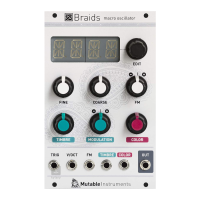Inputs and outputs
TRIG: This trigger input serves three purposes. 1/ Braids’ physical models need to be
“excited” by an impulse on this input to give birth to a sound. 2/ The other models will treat
the trigger as a reset signal, bringing the phase of the oscillator(s) to 0. 3/ This input can also
be used to trigger an internal AD envelope applied to the TIMBRE parameter, to create
sound animation and attacks without an external envelope module.
V/OCT: 1V/Oct frequency CV input.
FM: Frequency modulation CV input – the scale and polarity of this signal is set by the FM
attenuverter.
TIMBRE and COLOR: Control voltages for the Timbre and Color parameters. A value of 0V
corresponds to the minimum position of the knob. A value of +5V corresponds to the
maximum position of the knob. This CV is offset by the current position of the knob.
OUT: Signal output. Loudness is model-dependent – for example a pure sine wave is always
at maximum amplitude; while a ring-modulated sine-wave will have peaks and valleys due to
amplitude modulation, and will thus sound quieter.
Models
CSAW
This model is inspired by a quirk/defect of the Yamaha CS80 sawtooth wave shape,
consisting of a fixed-width “notch” after the raising edge. The width of the notch can be
controlled by TIMBRE; and its depth and polarity can be controlled by COLOR – producing
phasing effects.
/\/|-_-_
This model produces the classic waveform trajectory from triangle to sawtooth to square to
pulse found in synthesizers such as the RSF Kobol or the Moog Voyager. TIMBRE sweeps
through the waveforms. COLOR morphs from several tonal characters by increasingly
removing the high-frequencies with a 1-pole filter, and recreating them with a waveshaper.
/|/|-_-_
This model blends a sawtooth wave with dephasing control, with a square wave with PWM.
TIMBRE controls the dephasing amount or pulse width, and COLOR morphs the waveshape
from sawtooth to square.
SYNC
This model synthesizes the classic 2-oscillator hardsync patch, with both oscillators emitting
square waves. The main oscillator frequency controls the master frequency. The interval
between master and slave is controlled by TIMBRE. COLOR controls the balance between
the two oscillators.
FOLD
This model is built with sine and triangle oscillators sent into a wavefolder. TIMBRE controls
the wavefolder strength, and COLOR controls the balance between the sine and triangle
signals sent to it.

